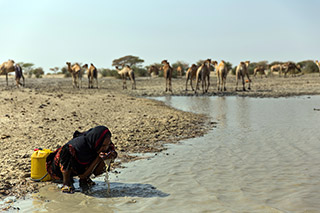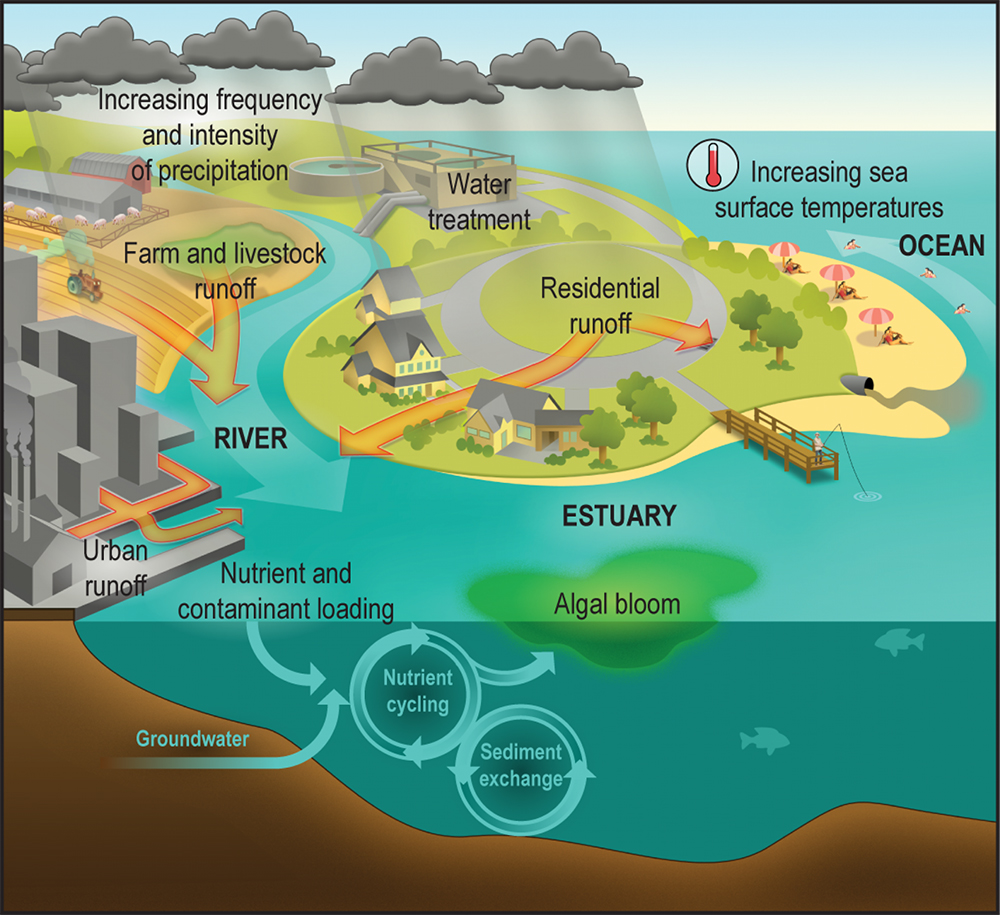Climate Change and Human Health

Climate change is expected to increase the incidence of water-related illnesses by disrupting marine and freshwater resources1 . Rising sea surface temperature, changes in frequency and intensity of precipitation, as well as agricultural and industrial runoff from more frequent storms, can create conditions for pathogens to thrive and contaminate bodies of water. These contaminants include bacteria, viruses, protozoa, and toxins, and exposure to them through ingestion, inhalation, or direct contact can cause water-related illness such as vibriosis.
Water Quality Impacts on Human Health
The effects of climate change can impact natural marine, coastal, and freshwater systems as well as manmade water infrastructure designed for treating drinking water, wastewater, and stormwater2 , 3 , 4 .

Eutrophication, an overabundance of nutrients, can result from runoff contaminated with fertilizers and pesticides and disrupt natural ecosystems. Excess nutrients can also cause algal blooms that produce toxins and directly contaminate fish and shellfish that humans consume. Ocean acidification, the excess absorption of carbon dioxide, affects marine ecosystems and can also influence the growth of harmful algal species.
Extreme weather events and increased sea surface temperatures affect the growth and spread of pathogens and toxins5 . In most cases, water contamination and subsequent outbreaks of waterborne illnesses are caused by an extreme rainfall or weather event that produces flooding and releases industrial and agricultural runoff into a body of water. Flooding can overwhelm sewage treatment facilities causing bacteria like Legionella and Escherichia coli (E. coli) to grow and develop in stagnant water, such as in unused pipes.
Exposure to contaminated water can lead to adverse health effects from waterborne illnesses. Swimming or fishing in polluted water sources and consumption of affected seafood are the most common pathways of exposure. Some common water-related illnesses are diarrhea, giardiasis, dysentery, typhoid fever, E. Coli infection, and salmonellosis. Adverse health effects can include pain in the gastrointestinal, reproductive, neurological systems, and other symptoms. Continuous exposure can have long-lasting health impacts.
Opportunities for Public Health Improvement
Public health safeguards can reduce the risk of exposure to waterborne pathogens and toxins and limit outbreaks of water-related illnesses. These efforts can include monitoring and testing water quality following extreme weather events, setting water quality standards for drinking water, issuing advisories for consuming fish and shellfish, as well as enacting guidelines for recreation in a body of water.
Fortifying marine, coastal, and freshwater ecosystems by restoring and protecting wetlands can help reduce greenhouse gases through carbon sequestration. Promoting safe water quality can be accomplished by capturing and treating contaminated runoff, buffering bodies of water from storm surges, and natural filtration of contaminants.
Research Needs
More research is needed to better understand how toxins, pathogens, and chemicals affect marine species, especially those consumed by humans. For example, improved knowledge of the initiation, development, and termination of harmful algal blooms, as well as the exact nature of the toxins associated with them, can shed light on the extent to which people’s health can be affected.
Climate change, sea level rise, and coastal and watershed development are increasing the prevalence of waterborne pathogens. It will be important to evaluate and monitor exposures, especially complex mixtures of contaminants, and associated health risks.
-
Trtanj J, Jantarasami L, Brunkard J, Collier T, Jacobs J, Lipp E, McLellan S, Moore S, Paerl H, Ravenscroft J, Sengco M, Thurston J. 2016. Ch 6: Climate Impacts on Water-related Illness. The Impacts of Climate Change on Human Health in the United States: A Scientific Assessment. U.S. Global Change Research Program, Washington, DC, 157–188. [Full Text Trtanj J, Jantarasami L, Brunkard J, Collier T, Jacobs J, Lipp E, McLellan S, Moore S, Paerl H, Ravenscroft J, Sengco M, Thurston J. 2016. Ch 6: Climate Impacts on Water-related Illness. The Impacts of Climate Change on Human Health in the United States: A Scientific Assessment. U.S. Global Change Research Program, Washington, DC, 157–188.]
-
Doney, Scott C., et al. Climate change impacts on marine ecosystems. Annual review of marine science 4 (2012): 11-37. [Abstract Doney, Scott C., et al. Climate change impacts on marine ecosystems. Annual review of marine science 4 (2012): 11-37.]
-
Woodward, Guy, Daniel M. Perkins, and Lee E. Brown. Climate change and freshwater ecosystems: impacts across multiple levels of organization. Philosophical Transactions of the Royal Society B: Biological Sciences 365.1549 (2010): 2093-2106. [Abstract Woodward, Guy, Daniel M. Perkins, and Lee E. Brown. Climate change and freshwater ecosystems: impacts across multiple levels of organization. Philosophical Transactions of the Royal Society B: Biological Sciences 365.1549 (2010): 2093-2106.]
-
Hughes, Gordon, Paul Chinowsky, and Ken Strzepek. The costs of adaptation to climate change for water infrastructure in OECD countries. Utilities Policy 18.3 (2010): 142-153. [Full Text Hughes, Gordon, Paul Chinowsky, and Ken Strzepek. The costs of adaptation to climate change for water infrastructure in OECD countries. Utilities Policy 18.3 (2010): 142-153.]
-
Levy, K., Smith, S. M., & Carlton, E. J. (2018). Climate Change Impacts on Waterborne Diseases: Moving Toward Designing Interventions. Current environmental health reports, 5(2), 272–282. [Abstract Levy, K., Smith, S. M., & Carlton, E. J. (2018). Climate Change Impacts on Waterborne Diseases: Moving Toward Designing Interventions. Current environmental health reports, 5(2), 272–282.] [Full Text Levy, K., Smith, S. M., & Carlton, E. J. (2018). Climate Change Impacts on Waterborne Diseases: Moving Toward Designing Interventions. Current environmental health reports, 5(2), 272–282.]
-
Trtanj J, Jantarasami L, Brunkard J, Collier T, Jacobs J, Lipp E, McLellan S, Moore S, Paerl H, Ravenscroft J, Sengco M, Thurston J. 2016. Ch 6: Climate Impacts on Water-related Illness. The Impacts of Climate Change on Human Health in the United States: A Scientific Assessment. U.S. Global Change Research Program, Washington, DC, 157â188. [Full Text Trtanj J, Jantarasami L, Brunkard J, Collier T, Jacobs J, Lipp E, McLellan S, Moore S, Paerl H, Ravenscroft J, Sengco M, Thurston J. 2016. Ch 6: Climate Impacts on Water-related Illness. The Impacts of Climate Change on Human Health in the United States: A Scientific Assessment. U.S. Global Change Research Program, Washington, DC, 157â188.]
-
Doney, Scott C., et al. Climate change impacts on marine ecosystems. Annual review of marine science 4 (2012): 11-37. [Abstract Doney, Scott C., et al. Climate change impacts on marine ecosystems. Annual review of marine science 4 (2012): 11-37.]
-
Woodward, Guy, Daniel M. Perkins, and Lee E. Brown. Climate change and freshwater ecosystems: impacts across multiple levels of organization. Philosophical Transactions of the Royal Society B: Biological Sciences 365.1549 (2010): 2093-2106. [Abstract Woodward, Guy, Daniel M. Perkins, and Lee E. Brown. Climate change and freshwater ecosystems: impacts across multiple levels of organization. Philosophical Transactions of the Royal Society B: Biological Sciences 365.1549 (2010): 2093-2106.]
-
Hughes, Gordon, Paul Chinowsky, and Ken Strzepek. The costs of adaptation to climate change for water infrastructure in OECD countries. Utilities Policy 18.3 (2010): 142-153. [Full Text Hughes, Gordon, Paul Chinowsky, and Ken Strzepek. The costs of adaptation to climate change for water infrastructure in OECD countries. Utilities Policy 18.3 (2010): 142-153.]
-
Levy, K., Smith, S. M., & Carlton, E. J. (2018). Climate Change Impacts on Waterborne Diseases: Moving Toward Designing Interventions. Current environmental health reports, 5(2), 272â282. [Abstract Levy, K., Smith, S. M., & Carlton, E. J. (2018). Climate Change Impacts on Waterborne Diseases: Moving Toward Designing Interventions. Current environmental health reports, 5(2), 272â282.] [Full Text Levy, K., Smith, S. M., & Carlton, E. J. (2018). Climate Change Impacts on Waterborne Diseases: Moving Toward Designing Interventions. Current environmental health reports, 5(2), 272â282.]


